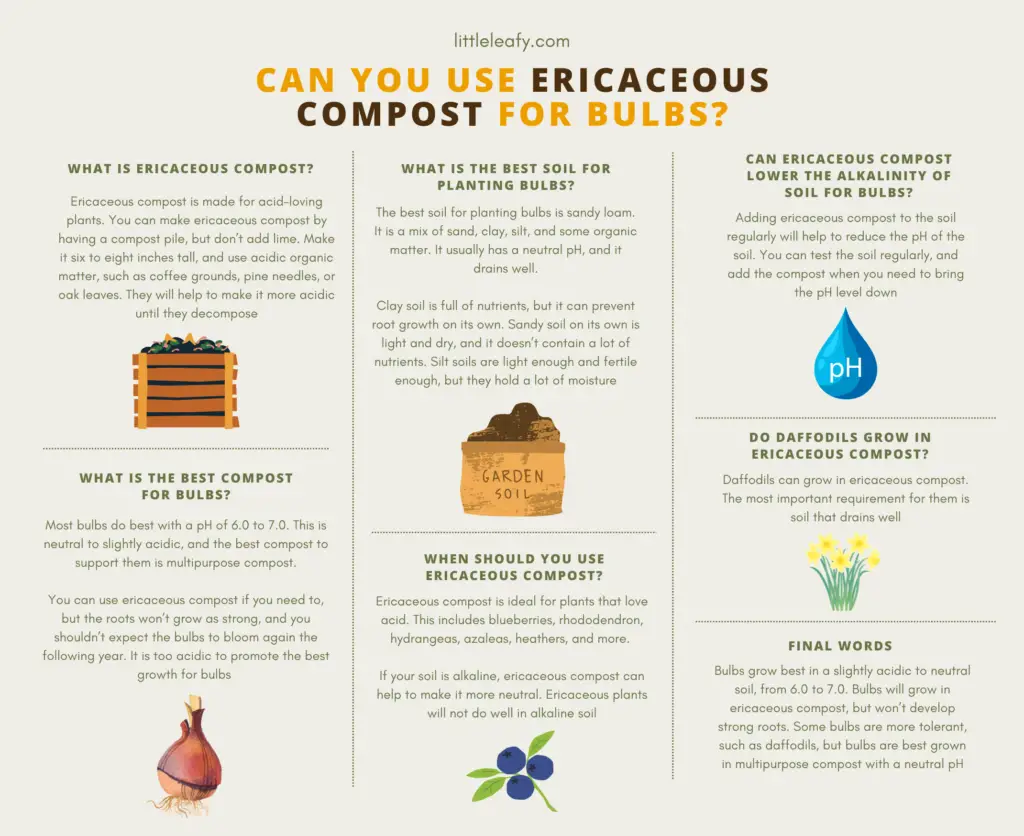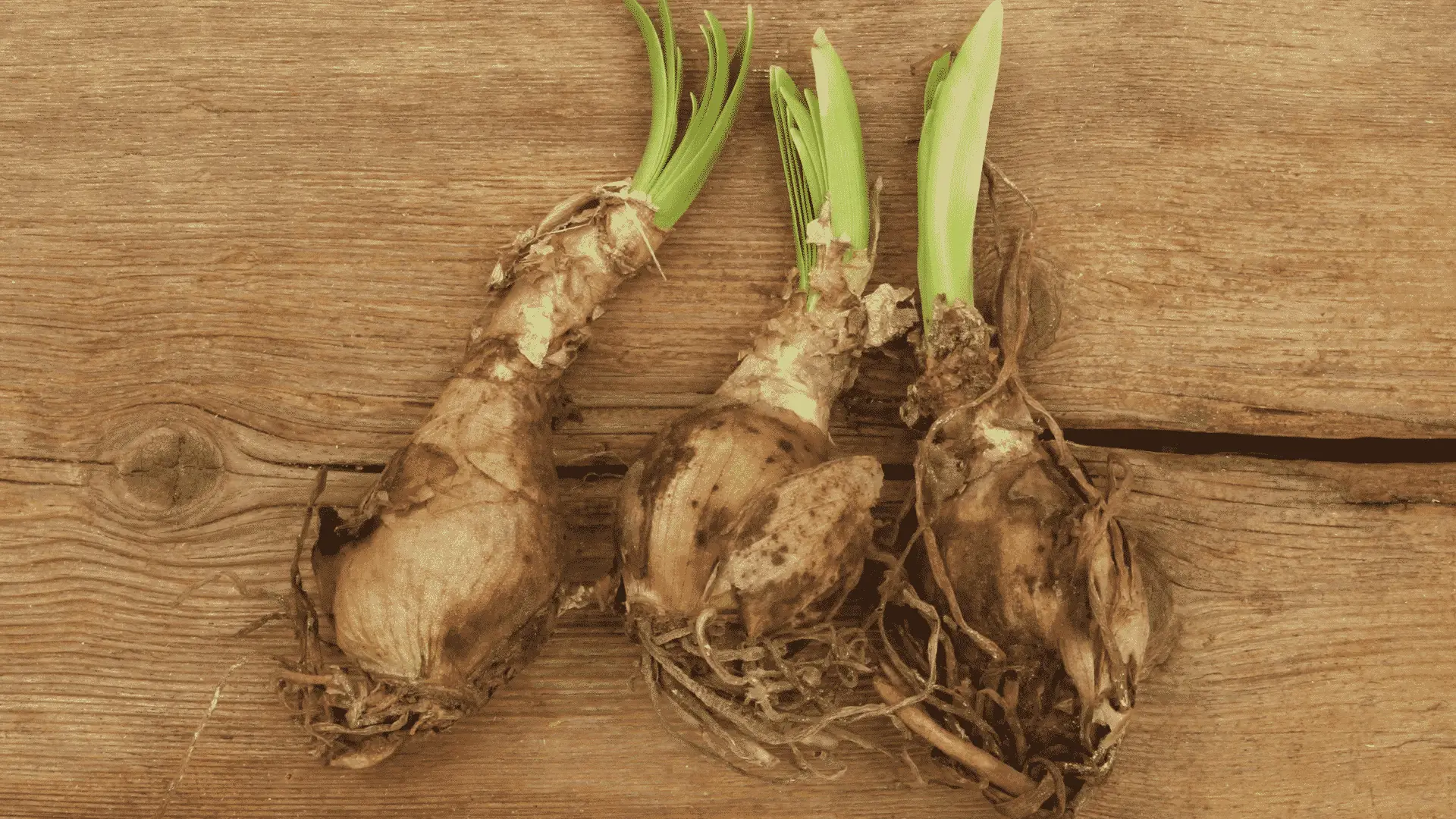Reading Time: 4 minutes 🍃
Each type of plant has an ideal pH level that can thrive. It is important to consider this if you want your plants to have healthy, strong roots and get the nutrients that they need. You can use compost to help your plants grow, but you need to choose the right one.
Ericaceous compost is acidic, and it is named for the types of plants that do well in it. They are part of the Ericaceae family, and they include azaleas, rhododendrons, hydrangeas, ferns, magnolia, blueberries, and more.
Bulbs produce daffodils, tulips, and other flowers, and they do best in soil with a neutral to slightly acidic pH between 6.0 and 7.0. They will grow in ericaceous compost, but they may not develop strong roots. Ericaceous compost has a pH of 4.0 to 5.0, which is lower than what bulbs need to thrive.

What Is Ericaceous Compost?
Ericaceous is a word that describes plants that are in the Ericaceae family. This includes plants that grow in conditions that are acidic or infertile. This compost is made for acid-loving plants.
You can make ericaceous compost by having a compost pile, but don’t add lime. Make it six to eight inches tall, and use acidic organic matter, such as coffee grounds, pine needles, or oak leaves. They will help to make it more acidic until they decompose. You have to keep adding them because once they decompose, the soil will go back to being more neutral.
If you want to use it as a potting mix, you can mix together perlite, compost, garden soil, and sand. This will make up half of your mixture, and the other half should be peat moss. This is the best substance with a high acid content to use.
What Is the Best Compost for Bulbs?
Most bulbs do best with a pH of 6.0 to 7.0. This is neutral to slightly acidic, and the best compost to support them is multipurpose compost. Most people mix three parts multi-purpose compost with one part grit for a container.
You can also purchase a compost made especially for bulbs called Bulb Fibre. Bulbs contain the embryo of a flower, so making sure that they have the moisture and nutrients they need is what is important to get them to bloom.
You can use ericaceous compost if you need to, but the roots won’t grow as strong, and you shouldn’t expect the bulbs to bloom again the following year. It is too acidic to promote the best growth for bulbs.
Bulbs also are known to rot if the soil is too wet, so it is important to make sure that any compost you use, as well as the soil, drains well.
What Is the Best Soil for Planting Bulbs?
The best soil for planting bulbs is sandy loam. It is a mix of sand, clay, silt, and some organic matter. It usually has a neutral pH, and it drains well. The bulbs will get enough nutrition and the roots will grow well.
If the soil is too acidic, it can prevent the roots of the bulbs from growing. Clay soil is full of nutrients, but it can prevent root growth on its own. It also holds too much water. It needs to be mixed with sand and other matter to be suitable for bulbs. If the bulbs sit in water, they will rot.
Sandy soil on its own is light and dry, and it doesn’t contain a lot of nutrients. It also holds heat in. This is why it should be mixed to create soil that is suitable for bulbs. Silt soils are light enough and fertile enough, but they hold a lot of moisture.
Loamy soil is ideal because it is a balance of all the different soil types. They do need organic matter added regularly, and for bulbs, it is good to add some sand to make sure that the soil drains well.
When Should You Use Ericaceous Compost?
Ericaceous compost is ideal for plants that love acid. This includes blueberries, rhododendron, hydrangeas, azaleas, heathers, and more.
If your soil is alkaline, ericaceous compost can help to make it more neutral. Ericaceous plants will not do well in alkaline soil. You should check the pH of your soil, and if you find that it is higher than 7.0, you have alkaline soil. You may need to grow your ericaceous plants in pots if your soil is too alkaline.
Ericaceous plants can’t survive in alkaline soil because they won’t get the vitamins they need. High pH soil provides nutrients for plants that need that kind of soil, but the nutrients needed by ericaceous plants will not be accessible.
Can Ericaceous Compost Lower the Alkalinity of Soil for Bulbs?
When the soil pH is too high, plants can have trouble growing and getting the nutrients they need. This stunts their growth. Water is often alkaline, and there is limestone in the soil that also increases alkalinity. Some people use ericaceous compost to organically lower the pH of their soil.
Adding ericaceous compost to the soil regularly will help to reduce the pH of the soil. You can test the soil regularly, and add the compost when you need to bring the pH level down.
Do Daffodils Grow in Ericaceous Compost?
Daffodils can grow in ericaceous compost. The most important requirement for them is soil that drains well. When people want to add color to their acid-loving plant garden, they often add in daffodils because they can tolerate the acidic pH. Daffodils are tolerant of a variety of soil conditions, and they will grow.
Final Words
Ericaceous compost is an acidic compost with a pH of between 4.0 and 5.0. Bulbs grow best in a slightly acidic to neutral soil, from 6.0 to 7.0. Bulbs will grow in ericaceous compost, but they won’t develop strong roots. They are unlikely to bloom beyond the first year. Some bulbs are more tolerant, such as daffodils, but bulbs are best grown in multipurpose compost with a neutral pH.
Sources
- https://www.thespruce.com/what-is-ericaceous-3269451

- https://www.theanswerbank.co.uk/Home-and-Garden/Gardening/Question1171660.html

- https://www.rhs.org.uk/plants/types/bulbs/planting


